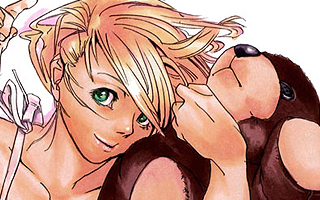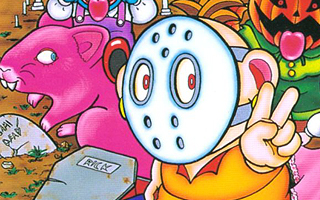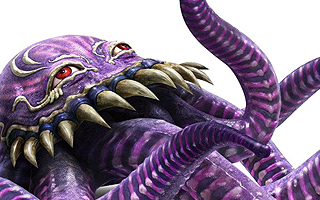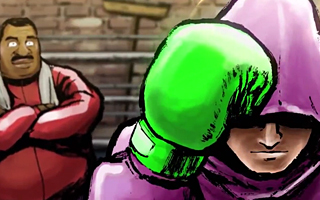Licensed Games
Top 10 Licensed Video Games of All Time!
There are always risks when you create new characters or franchises, but licensed games have built-in audiences and are proven commodities. For this reason, it makes a lot of sense for a publisher to base a game around established properties. Unfortunately, this also fosters an environment that allows publishers to release bad games. If consumers are willing to buy bad licensed games, then publishers will keep making them. On occasion, a developer will make an effort to understand why the licensed property was popular in the first place. The games on this list compliment the movies, shows, and comic books they were based on. Good licensed games will not only satisfy existing fans, but they can help expand the fan base and reach new audiences. In some cases, a licensed game will be successful enough to surpass the popularity of its source material.
10
Sam & Max Hit the Road
1993

Sam & Max Hit the Road is a graphic adventure game released by LucasArts in 1993. It used the same engine that earlier LucasArts games like Maniac Mansion and The Secret of Monkey Island did, so it’s understandable why many gamers would assume that the Sam & Max property began its life as a video game franchise. In actuality, the characters debuted in a comic book series called Sam & Max: Freelance Police that was published by Fishwrap Productions in 1987. The comics were well-received by critics, but the series didn’t gain much attention until after the video game was released. Incidentally, the style of the comic was perfectly compatible with the trademark LucasArts humor that gamers had come to know and love. This was largely due to the fact that the original creator of Sam & Max, Steve Purcell, was hired by LucasArts in 1988 and had worked on several of the company’s adventure games as an artist and animator.
9
Parasite Eve
1989

Parasite Eve is a Japanese novel that was written by Hideaki Sena and first published in 1995. A film adaptation of the novel was released in Japan in 1997 and also pre-dates the video game. The 1998 PlayStation game from Square technically serves as a detached sequel to the novel. Square’s adaptation combines elements from RPGs and the survival horror genre, and explores many of the themes from the novel (including cell biology and mitochondrial DNA). The story ties in with the novel, but it’s centered around a new cast of characters. Aya Brea (the central protagonist of the video game) is actually the daughter of Mariko Anzai (a central character in the book). It’s understandable why someone would be unaware of the game’s origins. After all, the Parasite Eve film wasn’t released in the United States until 2001, and the original novel wasn’t published in North America until 2005! The game was successful enough to warrant sequels of its own, so it’s not surprising that many associate the series primarily with the video game medium.
8
Teenage Mutant Ninja Turtles
1989

You couldn’t walk into an arcade in the early ’90s without seeing a licensed Konami game. The Simpsons, X-Men, and the oft-overlooked Asterix are all worth mentioning, but Teenage Mutant Ninja Turtles was their biggest hit by far. Konami made great use of the Ninja Turtles license and used characters from the cartoon, films, toy line, and comic books. All four turtles could fight alongside each other too, since the arcade game supported four players. The levels in TMNT were decidedly more interactive than those typically found in the genre. You could knock street signs over, set off exploding barrels, or send projectiles flying back toward your foes. Instead of randomly wandering onto the screen, your enemies would jump out of manholes, pile out from the backs of vans, and break through shop windows. You could never be quite sure where your enemies would show up next, and this kept the game exciting. From the opening stage in a burning building to the final confrontation with Shredder, TMNT is solid from beginning to end. If you can get Krang’s music out of your head, you’re a better man than I.
7
DuckTales
1989

Licensed games will often sell regardless of whether or not they are any good, so it’s all-too-common for a publisher to slap a license on a sub-par game and wait for the money to roll in. Capcom always took a different approach, and their lineup of Disney games were among the very best the NES had to offer. They released over a dozen Disney games in the late ’80s and early ’90s, but DuckTales is their most timeless effort. The game’s characters and locations feel like they were pulled straight out of the cartoon, and the levels are loaded with familiar faces like Launchpad McQuack, Gizmo Duck, and the Beagle Boys. The goal in the game is simply to travel the globe looking for treasure, but it’s fun from the moment you start playing. Scrooge McDuck’s cane is one of the coolest weapons in all of gaming. It can be used like a golf club to knock objects around or as a pogo stick to jump off the heads of enemies. The game isn’t particularly long or challenging, but the music is awesome, the graphics are charming, and jumping around on a pogo cane never gets old.
6
The Chronicles of Riddick: Escape from Butcher Bay
2004

In Escape from Butcher Bay, players assume the role of Riddick and are tasked with escaping from a prison complex. The game is a first-person shooter at its core, but the camera transitions to a third-person perspective during certain scenes in order to focus on the game’s adventure elements. Hand-to-hand combat plays a big role in the game, and players are able to form combos by stringing punches together. The implementation of stealth is probably the game’s most notable aspect. By moving silently, players can hide in the shadows, drag bodies out of sight, and get the drop on their enemies. Sneaking up on enemies and stabbing them with screwdrivers is somehow more satisfying than shooting them in the face. In their attempt to escape, players will inevitably have to interact with the prison’s residents and accept various assignments. By cooperating with guards and inmates, players can gain information, tools, and other rewards that will help them progress through the game. Escape from Butcher Bay successfully combines elements from multiple genres, and it’s better than the films that it’s based on.
5
Digital Devil Story: Megami Tensei
1987

The Megami Tensei series is comprised of over 40 games and has spun off into many entirely new franchises like Persona and Devil Summoner, but many of its fans are unaware that the series actually began as a trilogy of sci-fi/horror novels that were published in 1986. The novels were adapted to an OVA the following year and a licensed video game was released on the Famicom shortly thereafter. With its extensive dungeon crawling and strong emphasis on demons, Digital Devil Story: Megami Tensei helped establish the basic foundation that its many sequels would be built on. The game is noteworthy for being one of the earliest examples of a cyberpunk RPG, and it abandoned the high fantasy themes that the genre was known for in favor of a modern science-fiction setting. The game also pioneered concepts like summoning, and it included monster catching years before Pokémon existed. Megami Tensei is one of the most influential JRPG franchises of all time, and the success of the video games have overshadowed their original source material in many regards.
4
Marvel Super Heroes
1995

Marvel Super Heroes was neither the first nor the best Marvel game that Capcom released, but it helped to establish Marvel’s characters and spiked interest in their comics in Japan. Marvel’s roots date back to the 1930s and their characters have universal appeal, but they haven’t always been popular in the Land of the Rising Sun. Marvel attempted to make inroads in the 1970s and a hilarious live-action Spider-Man TV show was even produced, but many of their efforts were outright rejected. The 1994 release of X-Men: Children of the Atom helped Marvel gain a little traction. Capcom had pretty much perfected the formula for 2D fighting games, and the X-Men were a perfect fit for the genre. The release of Marvel vs. Capcom in 1995 expanded on the formula and highlighted a more diverse roster of characters from the entire Marvel universe. Marvel’s comics never had a lot of traction in Japan, but it was impossible to ignore the likes of Iron Man, Hulk, and Captain America when they were featured in a frenetic fighting game from one of the best game developers on the planet. Marvel Super Heroes served as the first in a long line of successes that would solidify Marvel as a brand in Japan. A case could be made that Marvel benefitted more from the licensing agreement than Capcom did, which makes it a rare breed indeed.
3
South Park: The Stick of Truth
2014

The South Park games that were released between 1998 and 2000 were blatant cash grabs that did no favors to the franchise. Creators Trey Parker and Matt Stone disavowed the games and publicly criticized Acclaim for how they handled the license. The negative reaction to the games made Parker and Stone more protective of their property, and they denied several licensing requests in the years that followed. After nearly a decade without any South Park video games, the duo reached out to Obsidian Entertainment to discuss the creation of an RPG. In the name of authenticity, Parker and Stone insisted that the game retain the visual style of the TV show. The pair also wrote the script, consulted on the design, voiced many of the characters, and even provided the initial funding. The development process took many years and the game was postponed on multiple occasions, but it was worth the wait and The Stick of Truth was universally praised for how faithful it was to its source material. The game’s graphics were almost indistinguishable from an episode of the show, and the writing was consistently funny and provocative. The Stick of Truth was a love letter to South Park fans and a way to atone for the horrible South Park games of the past.
2
Batman: Arkham Asylum
2009

Batman: Arkham Asylum borrows heavily from the DC animated universe and even features many of the same voice actors, but it stands on its own merits. Batman is the perfect video game character in many ways. He can beat up endless waves of enemies, he has an assortment of interesting gadgets at his disposal, and he has the whole “world’s greatest detective” thing to fall back on if he ever gets tired of punching people in the face. Arkham Asylum is designed in a way that allows you to fully explore Batman’s diverse skillsets. Despite his abilities, Batman is a character who is largely defined by his enemies. Arkham Asylum is a perfect example of this. The plot of the game sees Batman trapped in Arkham Asylum with his incarcerated foes, and this makes the inevitable encounters with various super villains seems surprisingly organic. The manner in which Batman’s past is relayed to the player via hallucination-induced nightmares courtesy of Scarecrow is a brilliant example of how characters can be developed through gameplay rather than relying purely on exposition. We’ve been introduced to countless versions of Batman since the character was introduced in 1939, but Batman: Arkham Asylum had one of the best interpretations of the caped crusader I’ve ever seen. Move aside, Adam West.
1
GoldenEye 007
1997

GoldenEye 007 for the Nintendo 64 follows the movie’s plot, focuses on the same characters, and is set in the same locations. The game is fondly remembered for its single-player campaign and multiplayer modes, and it was noteworthy for its diversity. Some missions required stealth while others favored a more aggressive approach. Some stages featured wide-open areas while others were confined to tight spaces. Whether you were sniping soldiers from afar, rescuing girls from trains, or sneaking up on unsuspecting soldiers in the bathroom, the game did a great job of highlighting the best moments of the movie. GoldenEye 007 revolutionized console-based first-person shooters and was one of the first games in the genre to truly break free from the DOOM mold. The game was a permanent fixture on sales charts for many months and was the best-selling game in North American in 1998 despite being released in 1997. People were still actively playing GoldenEye 007 years after its release, and two additional James Bond movies had come and gone during the height of the game’s popularity. It’s one thing to overshadow an obscure Japanese novel, but GoldenEye 007 overshadowed one of the most powerful media franchises in the world.





Do you agree with this list? Let us know what you think by leaving a comment below. Your opinion matters!